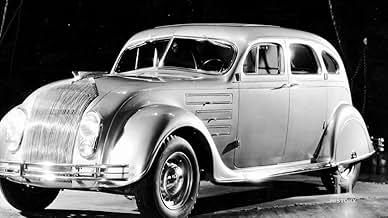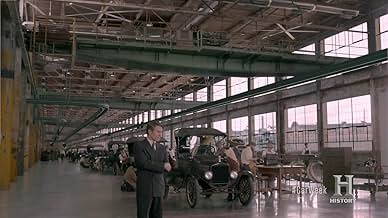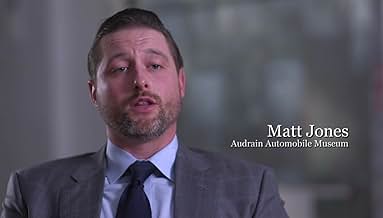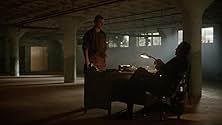The history and influence of cars in America.The history and influence of cars in America.The history and influence of cars in America.
Browse episodes
Featured reviews
This series is a nice overview of the development of the car industry and its impact on society, which is obvious from the name of the series (The Cars That Made America"). It's not a biography of any of the major players, although they certainly are there, warts and all. Nor is it a documentary on cars per se. While it does give us lots of biographic details and lots of engineering drawings, etc. the focus of the series is on how cars changed the way we live. The producers succeed admirably.
Overall, the series did a fairly decent job of laying out the story of the automobile in America, especially for viewers who know little about the car industry and simply want to be entertained. However, for car buffs and history fans anticipating an informed six-hour road trip through time, the series fell into the familiar traps of most docudramas: cheesy re-creations, an oversimplified and tabloid-style story line, and a host of inaccuracies. The series seems to me to have been rushed into production. Most disappointing was the failure---for reasons of either time or budget, or both---to take advantage of the treasure trove of archival film footage and sound recordings available at museums, libraries, and labor and automobile archives in the Detroit area. Whatever footage was used appears to have been pulled directly off a VHS copy of some old documentary.
The lineup of historians, biographers, and journalists added context to what was being dramatized. But in addition to these talking heads (and the amiable NASCAR drivers obviously trotted out for their "star" value), it would have been nice to hear from "witnesses" with first-hand or family knowledge of some of the personalities and events described. It's not like these people don't exist, especially in the Detroit area. With a little digging, the producers could have found retired factory workers, designers, executives, union organizers, etc., or their children and grand-children, as well as the offspring of auto pioneers. It also would have been a treat to see more of the actual Motor City (many of the sites associated with the story still exist) instead of whatever stand-ins in Texas and New York were used. The real homes of Henry and Edsel Ford are still around, for example, as are many factories and other historic sites.
I don't know if Car Week is now "a thing" on History Channel, or if a second edition of "The Cars That Made America" is planned. If there is a follow-up series, I'd like to see it concentrate on some of the many characters and cars either entirely left out of the first series or given short shrift, such as Ransom Olds, Henry Kaiser, Studebaker, Nash, Harley Earl and the Corvette, etc. And I hope they spend a few bucks on a reliable researcher in Detroit.
The lineup of historians, biographers, and journalists added context to what was being dramatized. But in addition to these talking heads (and the amiable NASCAR drivers obviously trotted out for their "star" value), it would have been nice to hear from "witnesses" with first-hand or family knowledge of some of the personalities and events described. It's not like these people don't exist, especially in the Detroit area. With a little digging, the producers could have found retired factory workers, designers, executives, union organizers, etc., or their children and grand-children, as well as the offspring of auto pioneers. It also would have been a treat to see more of the actual Motor City (many of the sites associated with the story still exist) instead of whatever stand-ins in Texas and New York were used. The real homes of Henry and Edsel Ford are still around, for example, as are many factories and other historic sites.
I don't know if Car Week is now "a thing" on History Channel, or if a second edition of "The Cars That Made America" is planned. If there is a follow-up series, I'd like to see it concentrate on some of the many characters and cars either entirely left out of the first series or given short shrift, such as Ransom Olds, Henry Kaiser, Studebaker, Nash, Harley Earl and the Corvette, etc. And I hope they spend a few bucks on a reliable researcher in Detroit.
The one thing that I found lacking in an otherwise very good series is the almost complete disregard for the independent carmakers. In many cases these companies and the people who ran them took the point for Automotive innovation, while the big three simply copied their innovations. Companies like Studebaker, Nash, Hudson aren't even mentioned.
Serious omissions were made in some of the "also-rans." The Stanley Steamer was not mentioned. And, too often, starting with the mid-50s, any car nearby would do. Other reviewers already mentioned the Mercury being touted as a Chevy. Later, DeLorean was modifying a 1963 Buick LeSabre. At least it was the right car company. But, these Buicks had horrible top ends; the valves were way too small to accommodate efficient breathing. I'm sure an early model of GTYO could have been found top make it more realistic.
Don't let the sour grapes from the gear heads fool you. This docudrama achieves its purpose of a comprehensive overview of the auto industry's emergence and integral part of the industrial revolution in the United States. And, how it interconnected with, steel, railroads, petroleum, finance, a national highway road system, the rise of labor unions, war efforts, and all the rest, to become the greatest economic engine the world has ever seen.
Did you know
- ConnectionsEdited from La Grande Course autour du monde (1965)
- How many seasons does The Cars That Made America have?Powered by Alexa
Details
- Release date
- Country of origin
- Official sites
- Language
- Also known as
- L'incroyable histoire de l'automobile américaine
- Production company
- See more company credits at IMDbPro
- Color
Contribute to this page
Suggest an edit or add missing content






























